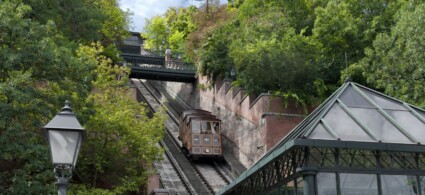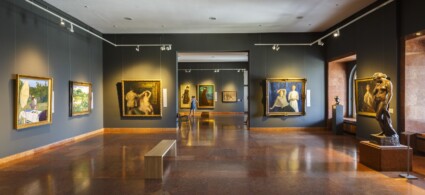
The majestic Buda Castle rises above the city of Várhegy, the hill of Budapest. The Castle has always had a turbulent history which reflects the different ups and downs of the history of Hungary.
Today the Castle, which is often called the Royal Palace, is home to a number of cultural institutes, including two museums: the Hungarian National Gallery and the Budapest Historical Museum.
The main structure of the Buda Castle is more austere compared to its previous versions. The interiors kept that abundance of ornamentations and decorations, which was typical of the past. Despite its history made of continuous destructions and reconstructions, the Castle is still an imposing complex facing the Danube for about 300 meters.
The castle is made of a number of wings, going from wing A to F, arranged around the Lion Courtyard, which is surrounded by the National Library, the National Gallery, and the Budapest History Museum.
Most of visitors access to the Buda Castle from St. George Square to the north side, where the funicular connects the hill with the Chain Bridge and Pest. A decorative gate from the beginning of the 20th century separates the square from the Palace. Near the door there is a bronze statue featuring a large bird representing the Kingdom of Hungary perched atop a pedestal.
The Hungarian National Gallery occupies four wings of the palace, where there are the artworks made by Hungarian artists, from Middle Age to today. Do not miss a visit to the collections of 1300 and 1400, exhibited in the former throne room. There is also a very accurate collection of Hungarian Romanticist paintings.
To the west of the courtyard, opposite the Gallery, there is the National Library which occupies the F wing of the palace. The Library was founded at the beginning of 1800 by Ferenc Széchényi who donated his private collection which was made of more than 1500 books and manuscripts. Today the library holds a copy of every single book published in Hungary.
The most southern wing of the palace is home to the Budapest History Museum, which covers the history of the city from prehistory to modern days. The museum offers the opportunity to see some ruins and reconstructions of the Medieval palace, including the Gothic chapel and the Knights’ Hall.
To discover Buda Castle Hill at its best, we recommend that you take part in a guided tour of the city.
The gardens and the courtyards of the Buda Castle are ope every day, 24 hours a day. Very often festivals take place in these spaces, therefore it is required to have a ticket in order to enter.
The Palace can be visited according to the Gallery and Museum opening times. The National Gallery opens from Tuesday to Sunday from 10.00 to 18.00. The History Museum is open everyday except on Mondays. During autumn and winter months the palace closes at 16.00 rather than at 18.00.
After visiting the Buda Castle it is possible to visit also some of the city’s most famous monuments located nearby, including:

Just in front of the Chain Bridge there is the tunnel passing through the hill on which the Buda Castle stands. It was designed by the same engineer who built the first permanent bridge over Budapest, that is to say Adam Clark. The tunnel was open for foot traffic in 1856 – today it is no longer accessible – and for motor traffic during the following year.
The bridge is long 350 meters, almost as much as the Chain Bridge, and it is large 9 meters and tall 11 meters. The gallery entrance facing Pest is characterized by a majestic decoration in Neo-Classical style. The tunnel is considered the gateway to the city and it is used to calculate all distances between the capital to other cities. The square located just across from the tunnel is dedicated to Clark.
A first rudimental fortification dates back to the 14th century. After the Mongol tribes had invaded Hungary, King Béla IV decided to build a shelter surrounded by walls. Today there is no evidence left of this first construction.
During the Renaissance, King Matthias undertook some changes to the castle, which reflected the style of that time. When Budapest was occupied by the Ottomans between 1541 and 1686 the castle was destroyed. Eventually the Habsburg gave a new castle to the city. The structure was built between 1714 and 1723 in Baroque style.
During the revolt of the Hungarian against the Hapsburg regime, in 1849, much of the Castle was destroyed. It was reconstructed only after establishing a compromise with the Habsburg. After the German invasion during World War II, the castle was severely damaged once again. Reconstruction works started in 1950 following a classic style design by architect István Janáki.
During the reconstruction works, the ruins of the Renaissance period were found and integrated to the new complex.
City Card allow you to save on public transport and / or on the entrances to the main tourist attractions.




